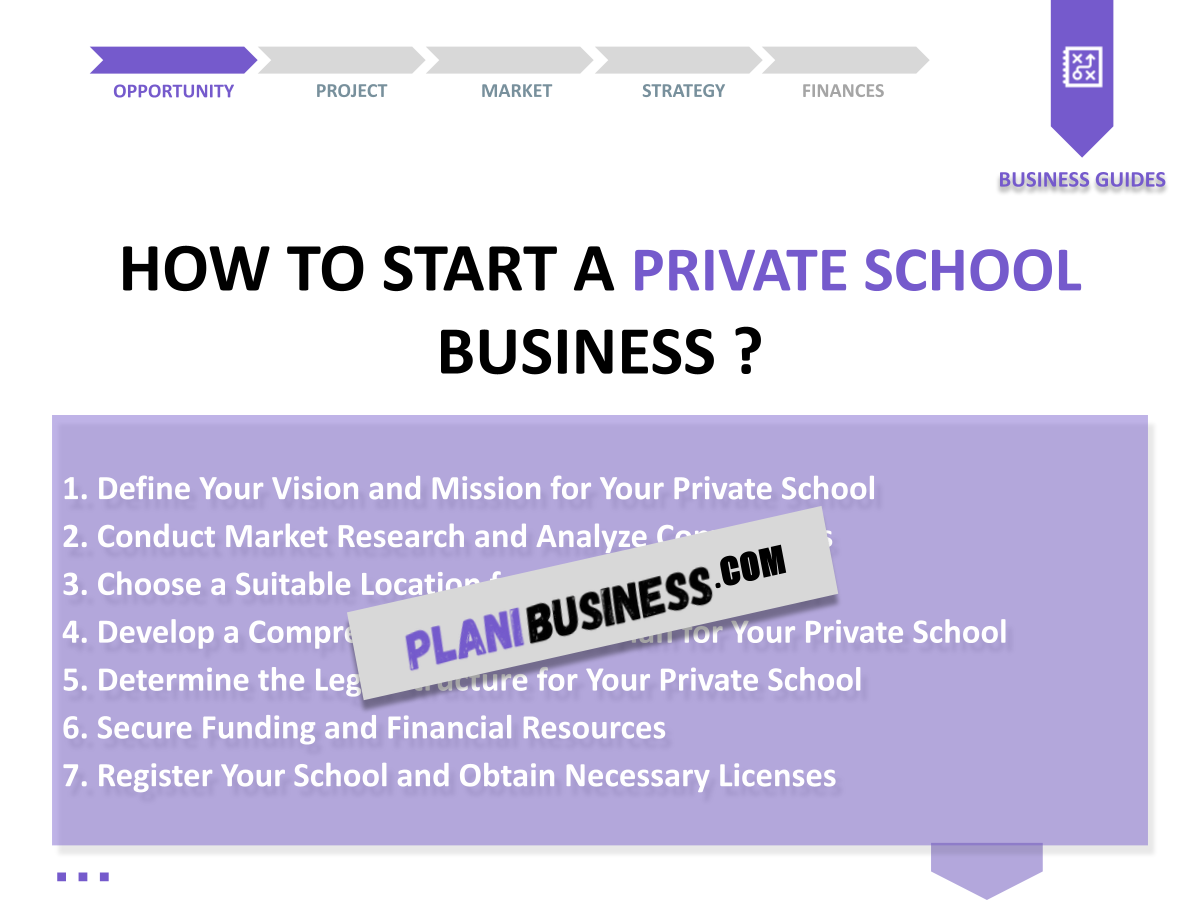Are you considering embarking on the journey of creating your own educational institution? You’re not alone! In recent years, the number of private schools has surged, driven by parents seeking tailored educational experiences for their children. The demand for specialized learning environments has created ample opportunities for aspiring educators and entrepreneurs. If you’re curious about how to start a private school, you’re in the right place! This guide will walk you through the essential steps to establish a successful private school.
- Understand your vision and mission.
- Conduct thorough market research.
- Choose the perfect location.
- Develop a comprehensive business plan.
- Navigate legal structures and requirements.
- Secure funding and resources.
1. Define Your Vision and Mission for Your Private School
When it comes to how to start a private school, the foundation lies in defining your vision and mission. These elements are crucial for guiding your school’s direction and purpose. Start by asking yourself:
- What educational philosophy do I believe in?
- What values do I want my school to promote?
- What unique offerings will differentiate my school from others?
It’s essential to articulate your vision clearly. For example, if you’re passionate about fostering creativity, your mission might focus on innovative teaching methods and hands-on learning experiences.
Here’s a simple table to illustrate how you might structure your vision and mission:
| Vision | Mission |
|---|---|
| To inspire lifelong learners who embrace creativity. | To provide an engaging curriculum that nurtures individual talents. |
| To cultivate a diverse and inclusive community. | To empower students through a supportive and collaborative environment. |
By defining your vision and mission, you’ll create a strong foundation for your private school that resonates with parents, students, and staff alike.
2. Conduct Market Research and Analyze Competitors
Once you have a clear vision, the next step in learning how to start a private school is conducting thorough market research. Understanding the landscape of private education in your area is crucial for identifying opportunities and challenges. Here’s how to approach this process:
- Analyze Existing Schools: Look at the private schools already operating in your vicinity. What programs do they offer? What are their strengths and weaknesses?
- Identify Gaps: Consider what unique value your school can provide. Are there specific educational philosophies or curricula that are underrepresented?
- Gather Community Insights: Conduct surveys or focus groups with parents and community members. Ask them about their preferences, needs, and concerns regarding education.
Tools like Google Trends can help you gauge interest in various educational topics, while local educational reports can provide insights into demographic trends. Here’s a quick overview of what to look for in your research:
| Research Focus | Key Questions |
|---|---|
| Demographics | What is the population size and growth rate of families with school-aged children? |
| Competitor Analysis | What are the strengths and weaknesses of existing schools? |
| Community Needs | What do parents value most in their children’s education? |
By conducting thorough market research and analyzing competitors, you’ll be equipped to make informed decisions that will set your private school up for success.
3. Choose a Suitable Location for Your Private School
Choosing the right location is a critical step in how to start a private school. The location can significantly influence enrollment numbers and the overall success of your institution. Here are some factors to consider when selecting a site:
- Accessibility: Ensure the location is easily reachable for families. Proximity to public transportation can be a big plus.
- Safety: Research the safety of the neighborhood. Parents want to feel secure sending their children to school.
- Community Needs: Consider the demographics of the area. Is there a demand for the type of education you want to provide?
Once you have a list of potential locations, it’s beneficial to visit each site and evaluate them in person. Consider factors such as space for classrooms, recreational areas, and future expansion possibilities. Here’s a quick table summarizing key location attributes:
| Location Attribute | Importance |
|---|---|
| Accessibility | Ensures families can easily reach the school. |
| Safety | Provides peace of mind for parents. |
| Community Demographics | Aligns school offerings with local needs. |
Choosing the right location is not just about convenience; it’s about creating an environment where students can thrive. Take your time to evaluate each option carefully.
4. Develop a Comprehensive Business Plan for Your Private School
Now that you have a clear vision and a potential location, the next step in how to start a private school is to develop a comprehensive business plan. This document will serve as your roadmap and guide you through the initial stages of establishing your school. Here’s what to include in your business plan:
- Executive Summary: A brief overview of your school, its mission, and its unique offerings.
- Market Analysis: Insights from your research about the demand for your school and the competitive landscape.
- Organizational Structure: Details about the governance of your school, including roles and responsibilities.
- Marketing Strategy: How you plan to attract students and engage with the community.
- Financial Projections: A breakdown of your expected income and expenses over the first few years.
It’s crucial to be thorough and realistic in your projections. Consider all potential costs, including facilities, staff salaries, educational materials, and marketing. I recommend checking out this business plan template for Private School. It’s super detailed and can save you a ton of time!
Creating a solid business plan will not only help you clarify your vision but will also be essential when seeking funding or support from investors. This document can be a valuable tool for keeping your school on track as it grows and evolves.
5. Determine the Legal Structure for Your Private School
Understanding the legal framework is essential when figuring out how to start a private school. Your school’s legal structure will influence your tax obligations, funding opportunities, and governance. Here are the common structures to consider:
- Non-Profit Organization: This structure allows you to apply for grants and receive tax-deductible donations. However, it comes with strict regulations and requires transparency in financial matters.
- For-Profit Entity: Operating as a for-profit school can offer more flexibility in decision-making and profit distribution. However, you may face limitations in funding options and potential scrutiny from the community.
- Charter School: This type of school operates under a charter granted by the state and can offer more autonomy than traditional public schools while still receiving public funding.
Consulting with a legal expert is highly recommended to navigate the complexities of educational law and ensure compliance with local, state, and federal regulations. Here’s a table summarizing the pros and cons of each structure:
| Legal Structure | Pros | Cons |
|---|---|---|
| Non-Profit | Tax-deductible donations, access to grants | Strict regulations, transparency required |
| For-Profit | Flexibility, profit distribution | Limited funding options, community scrutiny |
| Charter School | Autonomy, public funding | Accountability to the state, potential limitations |
Choosing the right legal structure is a crucial step that can significantly impact your school’s operation and sustainability.
6. Secure Funding and Financial Resources
One of the most challenging aspects of how to start a private school is securing adequate funding. A solid financial foundation is essential for your school’s success. Here are some strategies to consider:
- Tuition Fees: Determine a tuition structure that reflects the value of your educational offerings while remaining competitive within the market.
- Grants: Research available grants for educational institutions. Many organizations and foundations offer funding specifically for private schools.
- Donations: Build relationships with local businesses and community members who may be interested in supporting your school financially.
- Fundraising Events: Organize events such as bake sales, auctions, or fun runs to raise money and engage the community.
It’s important to create a detailed budget that outlines all potential expenses and income sources. This will help you manage cash flow effectively and identify any funding gaps. Here’s a simple breakdown of potential funding sources:
| Funding Source | Description |
|---|---|
| Tuition | Primary income source from enrolled students. |
| Grants | Financial assistance from governmental and non-profit organizations. |
| Donations | Contributions from individuals or businesses. |
| Fundraising Events | Community-driven initiatives to raise money. |
Securing diverse funding sources will help ensure your school’s financial stability and allow you to focus on providing quality education.
7. Register Your School and Obtain Necessary Licenses
Once you’ve established your vision, chosen a location, and secured funding, it’s time to make your private school official. This step is crucial in how to start a private school as it involves legal registration and compliance with educational standards. Here’s what you need to do:
- Register Your School: Submit the necessary documentation to your state’s department of education. This often includes your business plan, mission statement, and any other required forms.
- Obtain Licenses: Research and apply for any licenses or permits necessary to operate a private school in your area. This can vary significantly based on your location.
- Accreditation: Consider seeking accreditation from a recognized accrediting body. Accreditation can enhance your school’s credibility and attract more families.
It’s essential to stay organized throughout this process. Keep track of all submitted documents and communications with educational authorities. Here’s a simple checklist to help you stay on top of your registration:
| Task | Status |
|---|---|
| Complete registration forms | Pending |
| Submit business plan | Completed |
| Apply for necessary licenses | In Progress |
| Research accreditation options | Pending |
Successfully navigating the registration and licensing process will lay a solid foundation for your school and ensure that you meet all legal requirements.
8. Establish a Curriculum That Meets Educational Standards
The curriculum you offer is at the core of what makes your private school unique. Developing a strong curriculum is vital in how to start a private school as it directly impacts student learning and satisfaction. Here are some steps to guide you in creating an effective curriculum:
- Define Educational Goals: Determine the learning outcomes you want your students to achieve. This could include academic, social, and emotional goals.
- Research Standards: Familiarize yourself with local and national educational standards. Aligning your curriculum with these standards will help ensure your students receive a quality education.
- Incorporate Diverse Learning Methods: Consider using various teaching methods, such as project-based learning, hands-on activities, and technology integration, to cater to different learning styles.
Involving educators and community stakeholders in the curriculum development process can provide valuable insights and foster a sense of ownership. Here’s a table summarizing key components of an effective curriculum:
| Curriculum Component | Description |
|---|---|
| Core Subjects | Essential subjects like math, science, and language arts. |
| Electives | Courses that allow students to explore their interests, such as art or technology. |
| Assessment Methods | Tools to evaluate student progress, including tests, projects, and presentations. |
Creating a well-rounded curriculum that meets educational standards will not only enhance student learning but also attract families seeking quality education for their children.
9. Build Your School’s Brand Identity
Creating a strong brand identity is essential for your private school’s success. Your brand will communicate your values and mission, helping you attract students and families. Here’s how to establish a compelling brand identity:
- Develop a Unique Logo: Your logo should reflect your school’s mission and be easily recognizable. Consider working with a graphic designer to create a professional design.
- Create a Tagline: A catchy tagline can succinctly communicate your school’s purpose. For example, “Nurturing Minds, Shaping Futures” can resonate well with parents.
- Consistent Messaging: Ensure that all communications, whether online or offline, reflect your brand’s voice and values. This includes your website, social media, and promotional materials.
Here’s a simple table to summarize key elements of your brand identity:
| Brand Element | Description |
|---|---|
| Logo | A visual representation of your school’s identity. |
| Tagline | A memorable phrase that encapsulates your mission. |
| Color Palette | A consistent set of colors that reflects your school’s personality. |
By investing time in building a strong brand identity, you’ll create a sense of trust and recognition within the community, making it easier to attract students and families.
10. Create an Engaging Online Presence
In today’s digital age, having a professional online presence is vital for your private school. A well-designed website and active social media profiles can significantly enhance your visibility and engagement with prospective families. Here are steps to establish a compelling online presence:
- Design a User-Friendly Website: Your website should be easy to navigate and provide essential information about your school, including programs, enrollment processes, and contact details.
- Incorporate SEO Strategies: Use search engine optimization techniques to improve your website’s visibility on search engines. This includes using relevant keywords like how to start a private school in your content.
- Utilize Social Media: Create profiles on platforms like Facebook, Instagram, and Twitter. Share updates, success stories, and community events to engage with your audience.
Consider adding a blog section to your website where you can share educational resources, tips for parents, and insights into your school’s activities. Here’s a quick overview of essential elements for your online presence:
| Online Element | Importance |
|---|---|
| Website | Central hub for information and engagement. |
| Social Media | Connects with the community and promotes school activities. |
| Blog | Enhances SEO and provides valuable content to parents. |
Creating an engaging online presence will help you reach a broader audience, making it easier to attract students and establish your school as a valuable community resource.
11. Develop Marketing Strategies to Attract Students
Once your private school is established, effective marketing strategies are essential for attracting students and building your reputation. Here’s how to create a comprehensive marketing plan:
- Identify Your Target Audience: Understand the demographics of families you want to attract. Consider factors like age, location, and educational preferences.
- Utilize Digital Marketing: Leverage social media platforms, email newsletters, and online advertising to reach potential students and their families.
- Host Open House Events: Organize events where families can tour the school, meet staff, and learn about your programs. This personal interaction can be a powerful way to engage prospective families.
It’s also beneficial to gather testimonials and success stories from current students and parents. Positive word-of-mouth can be one of your strongest marketing tools. Here’s a table summarizing key marketing strategies:
| Marketing Strategy | Description |
|---|---|
| Target Audience Research | Identify the families most likely to be interested in your school. |
| Digital Marketing | Use online channels to reach and engage with prospective families. |
| Open House Events | Invite families to experience your school firsthand. |
By implementing a diverse marketing strategy, you’ll enhance your school’s visibility and attract more students, ensuring its growth and success.
12. Assemble a Dedicated Team of Educators
The success of your private school heavily relies on the quality of its educators. As you learn how to start a private school, assembling a dedicated team is crucial. Here are steps to help you build an effective faculty:
- Define Roles and Responsibilities: Clearly outline the roles you need to fill, including teachers, administrators, and support staff. This clarity will help you attract the right candidates.
- Hire Qualified Educators: Look for individuals who not only have the necessary qualifications but also align with your school’s mission and values. Conduct thorough interviews and consider practical teaching demonstrations.
- Provide Professional Development: Invest in ongoing training and support for your staff. This can help maintain high teaching standards and keep educators motivated.
Here’s a simple breakdown of essential roles for your school:
| Role | Responsibilities |
|---|---|
| Principal | Oversee school operations and ensure educational quality. |
| Teachers | Deliver curriculum and support student learning. |
| Administrative Staff | Manage school operations, finances, and communications. |
By assembling a dedicated team, you’ll create a positive learning environment that fosters student success and encourages community engagement.
13. Evaluate and Adapt Your School’s Programs Regularly
Finally, it’s essential to continuously evaluate and adapt your school’s programs to ensure they meet the evolving needs of students and families. Regular assessment is a key component in how to start a private school and maintain its success. Here are some strategies for effective evaluation:
- Gather Feedback: Regularly solicit feedback from students, parents, and staff. Surveys, focus groups, and suggestion boxes can provide valuable insights into areas for improvement.
- Assess Academic Performance: Monitor student performance through assessments and evaluations. Use this data to identify trends and areas where additional support may be needed.
- Adapt Programs: Be willing to make changes based on feedback and assessment results. This could involve updating the curriculum, introducing new extracurricular activities, or enhancing support services.
Here’s a table summarizing evaluation methods:
| Evaluation Method | Purpose |
|---|---|
| Surveys | Gather feedback from stakeholders. |
| Performance Assessments | Monitor student academic success and engagement. |
| Program Reviews | Evaluate the effectiveness of school programs and services. |
By regularly evaluating and adapting your programs, you’ll ensure your private school remains relevant, effective, and responsive to the needs of its students and families.
Conclusion
Starting a private school can be a fulfilling and impactful endeavor. By following the steps outlined in this guide, from defining your vision to assembling a dedicated team, you’ll be well on your way to creating an educational institution that meets the needs of your community. Remember, the journey may have its challenges, but the rewards of shaping young minds and contributing to the educational landscape are truly invaluable.
For further insights, consider exploring our articles on how to create a SWOT Analysis for Private School and how to build a Private School Marketing Plan. These resources will provide you with additional strategies and frameworks to enhance your school’s success.
FAQ
- What are the initial steps to start a private school?
The first steps include defining your vision and mission, conducting market research, and developing a comprehensive business plan. These foundational elements will guide your decision-making process. - How do I fund my private school?
Funding can come from various sources, including tuition fees, grants, donations, and fundraising events. Diversifying your funding sources will help ensure financial stability. - What legal requirements must I meet to start a private school?
Legal requirements vary by state but generally include registering your school with the local education authority, obtaining necessary licenses, and ensuring compliance with educational standards. - How can I develop a curriculum for my private school?
Start by defining educational goals, researching local and national standards, and incorporating diverse learning methods. Engaging educators and community stakeholders in this process can provide valuable insights. - What marketing strategies should I use to attract students?
Effective marketing strategies include identifying your target audience, utilizing digital marketing, hosting open house events, and gathering testimonials from current students and parents. - How do I choose the right location for my private school?
Consider factors such as accessibility, safety, and community demographics. The location should be convenient for families and conducive to a positive learning environment. - What qualifications should my teaching staff have?
Look for educators who not only possess the necessary qualifications but also align with your school’s mission and values. Conduct thorough interviews to ensure a good fit. - How often should I evaluate my school’s programs?
Regular evaluations should occur at least annually or biannually. Continuous feedback from students, parents, and staff can help identify areas for improvement and ensure that your programs remain effective. - What are the benefits of accreditation for my private school?
Accreditation enhances your school’s credibility, provides access to funding opportunities, and assures parents that you meet high educational standards. - How can I ensure my school remains financially stable?
Create a detailed budget, diversify funding sources, and regularly assess financial performance. Staying adaptable to changes in the educational landscape will also help maintain stability.







